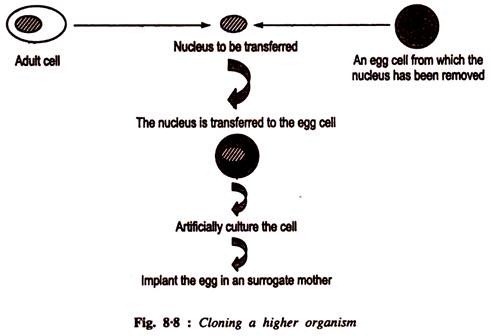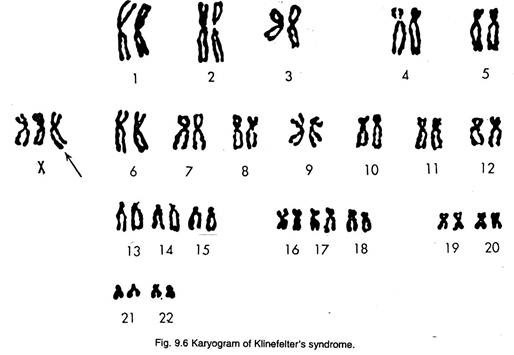In this article we will discuss about:- 1. History of Klinefelter’s Syndrome 2. Origin of Klinefelter’s Syndrome 3. Symptoms 4. Ascertainment and Phenotype 5. Cytogenetic Findings 6. Frequency.
History of Klinefelter’s Syndrome:
1. In 1942, Klinefelter, Refenstein and Albright found nine men with small testes, aspermia, elevated urinary gonadotrophins and gynecomastics. These persons were later designated as Klinefelter’s syndromic.
2. Bradbury(1956) found that such person is chromatin positive having 2X chromosomes in its Karyotype.
3. Jacob and Strong (1956) described the presence of 2X chromosomes in addition to a Y chromosome in its Karyotype.
4. Court Brown (1964) described that, in more than ¾ th cases, Karyotype is 47/XXY.
The affected person of Klinefelter’s syndrome is genotypically and phenotypically male but bears many female characteristics. But Klinefelter’s syndrome will unusually be the result whenever more than one X occurs in the presence of a Y.
Origin of Klinefelter’s Syndrome:
1. Due to nondisjunction during paternal gametogenesis or during the post-zygotic division.
2. “Anaphase-Lag” of Y chromosome.
Symptoms of Klinefelter’s Syndrome:
1. These individuals are normally tall, having sparse body hair, and knock knees; limbs tend to be long, hand and feet larger.
2. Mental retardation becomes more and more severe in addition with the increase of X chromosome number i.e. mental retardation is proportional to the no. of X.
3. Immature personality leading to inadequacy and lack drive.
4. Internally, exploratory laparotomy reveals that there is very little testes (2 cm in greater diameter, occasionally with “Ghost” tubules. Microrchidism (small-sized testes) occasionally with cryptorchism (testis abdominal).
5. Secondary sexual characters, such as axillary hair, pubic hair, facial hair are little developed.
6. Complete aspermia, well-developed breasts, broad pelvis, horizontal limit of pubic hair, feminine voice, gynacomastia occur in about 80% of cases.
7. Depressed thyroid function.
8. Decreased amount of androgen in blood.
9. Temporal recession of the hair due to lack of androgen.
10. These individuals are sterile. The Klinefelter male is capable of excretion and intercourse with occasional aspermic ejaculation.
11. Behaviourally, Klinefelter person tends to be socially inadequate and of limited intelligence and ambition.
12. Chronic pulmonic condition such as asthma, bronchiectasis, emphysema etc. are found.
Ascertainment and Phenotype of Klinefelter’s Syndrome:
The phenotype of Klinefelter’s syndrome is somewhat variable and ascertainment is often done by X chromatic survey.
Probably many Klinefelter individuals are of normal intelligence and leading normal lives except for subfertility problems and a proportion who are 46, XY/47, XXY mosaics may well be fertile. There is, however, a tendency toward lowering of I.Q.
Cytogenetic Findings:
Sex chromatin, Drumstick, X-linked gene are present, so same phenomenon occurred as in normal females:
1. Majority of patients have a 47/XXY karyotype. A porportion are 46, XY/47, XXY mosaics.
2. A 46/XY karyotype, without apparent mosaicism, is of average intelligence.
The presence of hyalinised testis suggests that these cases may be occult XXY’s i.e. a Y chromosome is or may be present at one time in some of the cells of the individual or Y chromosome in fact present but translocated to one or another chromosomes
3. It was found that the Y-chromosome had been ruptured and each of its fragments translocated to a member of groups D 13-15 and G 21-22, 46/XX is similar with the 46/XY karyotype.
4. In chromatin positive Klinefelter syndrome, individuals with abnormal sex chromosome constitution, the testicular maldevelopment is prepubertal whereas the chromatin-negative Klinefelter individuals with normal sex chromosome constitution and the testicular maldevelopment is post-pubertal.
The latter is again of two kinds:
i) Those with post-pubertal testicular atrophy exhibit varying degrees of hypospadias with completely hyalinised seminiferous tubules.
ii) Those with absence of germ cells, but without testicular atrophy , germinal epithelium is affected.
5. Ford (1959) showed that in a case of this syndrome, majority of cells (marrow cells) were XXY and a few XX. They concluded that zygote has been XXY and that Y had been lost from one of the earliest cells of embryo, thus representing mosaicism.
6. X polysomy in presence of a Y produces males whereas the XO condition results in females in human being, but XXY is a female and XO a mate in flies. This indicates that Y chromosome in man contains factor for maleness.
Frequency of Klinefelter’s Syndrome:
1. in XXY individuals – one within two male births.
2. In XXXY/XXXY individuals – One within 360 male births.
Average maternal age in 47/XXY Klinefelter’s syndrome is about 32.3 years

